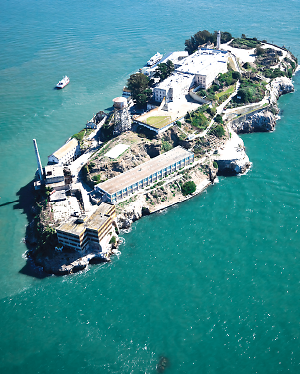Alcatraz Island deserves a place in history for much more than its stint as a storied federal penitentiary. People who consider the 22-acre island in San Francisco Bay only as the site of a notorious federal prison underestimate its role in American history.
Known as “The Rock” long before it became a prison, Alcatraz Island was a Civil War fortress and home of the first lighthouse on the West Coast. It was also the site of an influential American-Indian protest, and today it’s a bustling wildlife sanctuary and popular tourist attraction.
There is little history of Alcatraz Island before the 1700s; it is believed to have been so inhospitable as to be little used by American Indians, other than when they visited the island to collect eggs from its copious bird population. It entered the history books in 1775, when Spanish explorer Juan Manuel de Ayala charted San Francisco Bay and named one of the islands there “La Isla de los Alcatraces,” which translates as “The Island of the Pelicans.”
Alcatraz was the site of the first operational lighthouse on the West Coast. Congress authorized seven West Coast lighthouses in the early 1850s, and the Alcatraz lighthouse was the first to be completed. It served the Bay until April 1906, when it was damaged by the San Francisco earthquake. It was replaced by a taller tower in 1909. For years, the lighthouse and its foghorn were operated by live-in keepers, a living situation often fraught with danger. It became automated in 1963, just after the prison was closed. The lighthouse is still functional and has been a museum since 2000.
Alcatraz Played Role in Civil War
Fortification of the island by the Army Corp of Engineers between 1853 and 1858 created Fortress Alcatraz, which the U.S. Army intended to use to defend against approaches to San Francisco Bay. During the Civil War, the island housed 105 cannon and was used for storage of an arsenal of firearms. Although Alcatraz never fired its guns offensively, the fort was used to imprison Confederate sympathizers from 1861 to 1865, and it was the largest American fort west of the Mississippi River. The Army also began sending soldier-convicts to the Alcatraz fort in early 1860. Over the next 40 years, the island gradually became obsolete as a fortification and more important as a prison.
The island’s notorious stint as the site of a federal penitentiary began in 1933, when the U. S. Disciplinary Barracks on Alcatraz was acquired by the Department of Justice. It was designated a federal prison in August 1934, the nation’s first maximum-security civilian penitentiary. Alcatraz Prison, largely due to its isolated location, was conceived as a site in which difficult-to-manage prisoners from other institutions would be housed under one roof.
Rehabilitation Was Not a Goal
A 1971 documentary, “Alcatraz: Island of Hate,” described the arrival of the first group of 137 prisoners on August 11, 1934. Most of the prisoners were bank robbers and murderers. The prison initially had a staff of 155, and the climate of the prison was one of security, not rehabilitation.
For 29 years, the penitentiary held some of the nation’s most dangerous criminals and claimed that no prisoner ever successfully escaped. Those who tried were caught, shot and killed, drowned, or were never found and presumed to have drowned. By the early 1960s, however, it had become too expensive to maintain, and the buildings had begun to crumble from salt-water damage. Attorney General Robert Kennedy approved closing the penitentiary in 1963, despite objections of some members of Congress who said that islands like Alcatraz were the only answer to violent crime. The last 27 convicts left Alcatraz in leg-irons and handcuffs on March 21, 1963.
Alcatraz Island remained abandoned for years while entrepreneurs lobbied the government with ideas for development, none of which were successful.
But before there was Occupy Wall Street, there was Occupy Alcatraz, as the island played yet another riveting role on history’s stage. On November 9, 1969, a diverse group of American Indians calling themselves Indians of All Tribes, claimed the island, eventually mounting a full-scale occupation that lasted into 1971, the longest prolonged occupation of a federal facility by American Indians. The occupiers negotiated for the deed to the island, intending to build a university, cultural center, and museum. But the occupation dwindled when its leadership faltered, and some of the island’s buildings were vandalized and damaged. The government’s patience grew thin, and President Richard Nixon ordered the last few residents removed, an event that was accomplished peacefully.
Today, Alcatraz Island’s facilities are managed by the National Park Service as part of the Golden Gate Recreational Area, and its rocky shores are important nesting sites for numerous species of wild birds, including pigeon guillemots, cormorants, Heermann’s Gulls, Western Gulls, and night herons. ■

